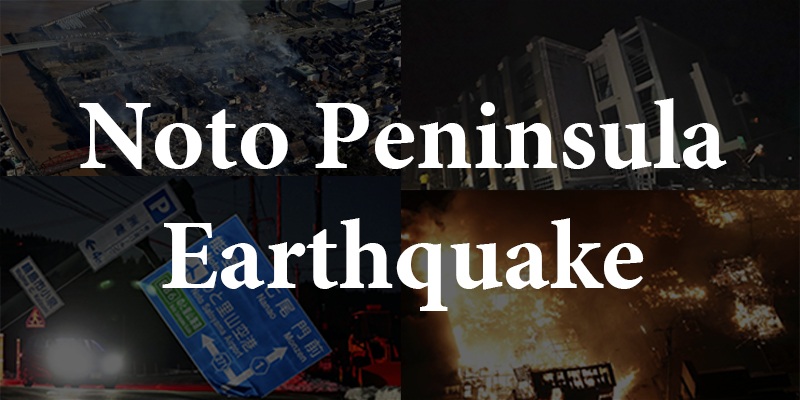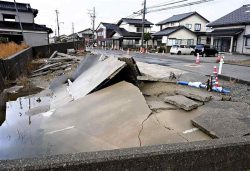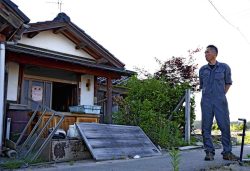SDF Working to Learn and Meet Needs of Noto Quake Evacuees; Supplies Arriving by Sea and Air, Skirting Damaged Roads
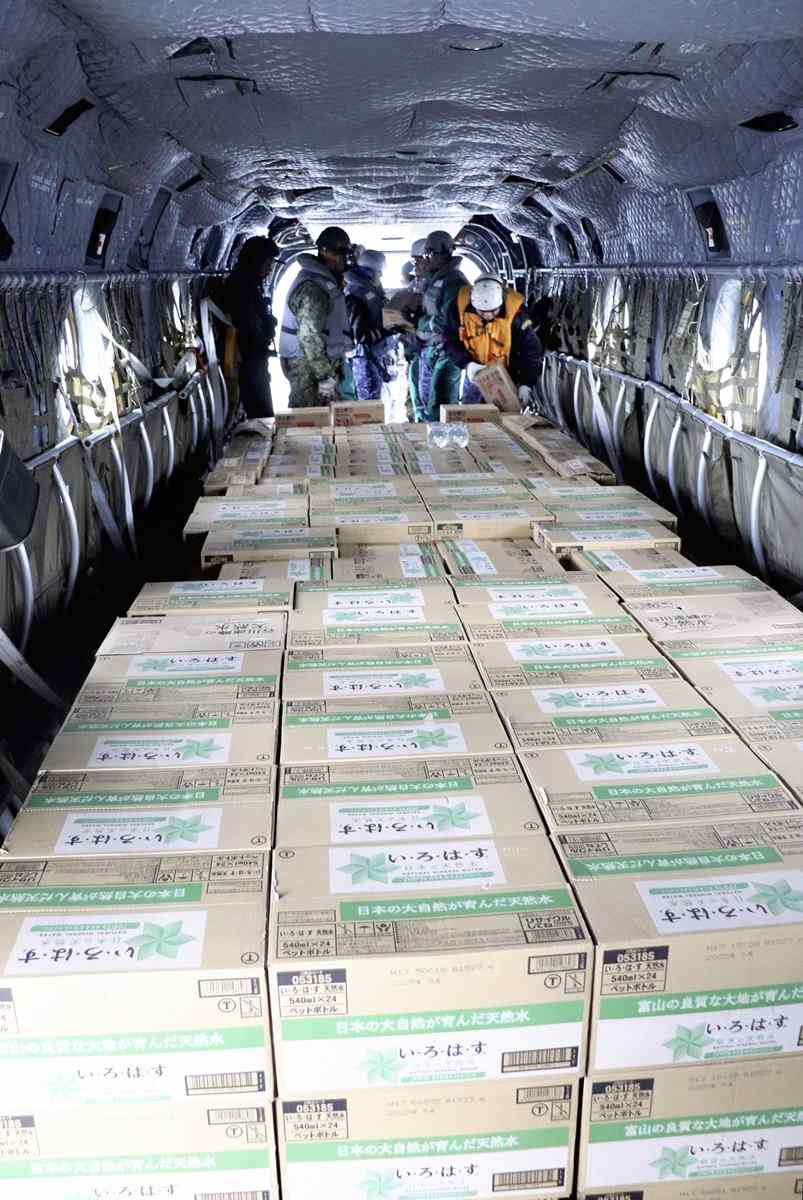
Supplies are seen loaded onto a CH-47 helicopter from the transport ship Osumi off the Noto Peninsula on Tuesday.
18:48 JST, January 11, 2024
With relief work hampered by heavy snowfall and roads blocked or closed, among other disruptions in the wake of the Noto Peninsula Earthquake, the Self-Defense Forces have deployed a transport ship and helicopter to transport supplies to ensure their delivery to evacuation centers in various parts of quake-stricken areas.
Having also formed a team to listen to the voices of those affected by the earthquake, the SDF is looking for ways to effectively respond to their needs in detail.
From sea and air
At around 9:40 a.m. Tuesday, a large CH-47 transport helicopter of the Ground Self-Defense Force landed in Nonoe Sogo Koen park in Suzu, Ishikawa Prefecture, which was covered with about 10 centimeters of snow. In places where the ground was exposed, cracks could be seen.
The aircraft was packed with hundreds of cardboard boxes containing water and food up to just behind the pilot’s seat. The boxes were brought from the Maritime Self-Defense Force transport ship Osumi, which was about 30 kilometers off the coast of the Noto Peninsula.
More than a dozen GSDF personnel who had been waiting on the ground loaded the boxes onto two vehicles. Twenty minutes later, the helicopter took off.
“Road conditions are still bad. We are doing our best to transport goods by sea and air as well,” said GSDF Capt. Hirokazu Kimura, who was working on relief operations in quake-stricken areas.
About an hour after taking off, the helicopter landed on the Osumi, which was sailing in the Sea of Japan. Amid strong sea winds, about 20 crew members promptly pulled a cargo bed with cardboard boxes on it close to the aircraft and loaded them onto it on the deck. The helicopter was again filled with boxes in about 10 minutes. The aircraft took off again for Suzu.
Roads cut off
The SDF began relief operations on Jan. 1 at the request of the governor of the prefecture to engage in rescue work and transportation of goods. The SDF began using Osumi as a maritime base of operations on Saturday. On Tuesday, the SDF transported water and food by sending its helicopter on three runs to Suzu and two to Wajima.
Many roads leading from the southern part of the peninsula were cut off in the northern area, including in both cities. Even after some debris was removed to allow road traffic, congestion and one-way traffic restrictions still hampered the smooth flow of traffic. The national highway along the sea at the northern end of the peninsula was still closed to traffic.
“Since people use the supplies every day, we need to continuously send them. An airlift is a very effective means for the purpose,” a senior SDF official said.
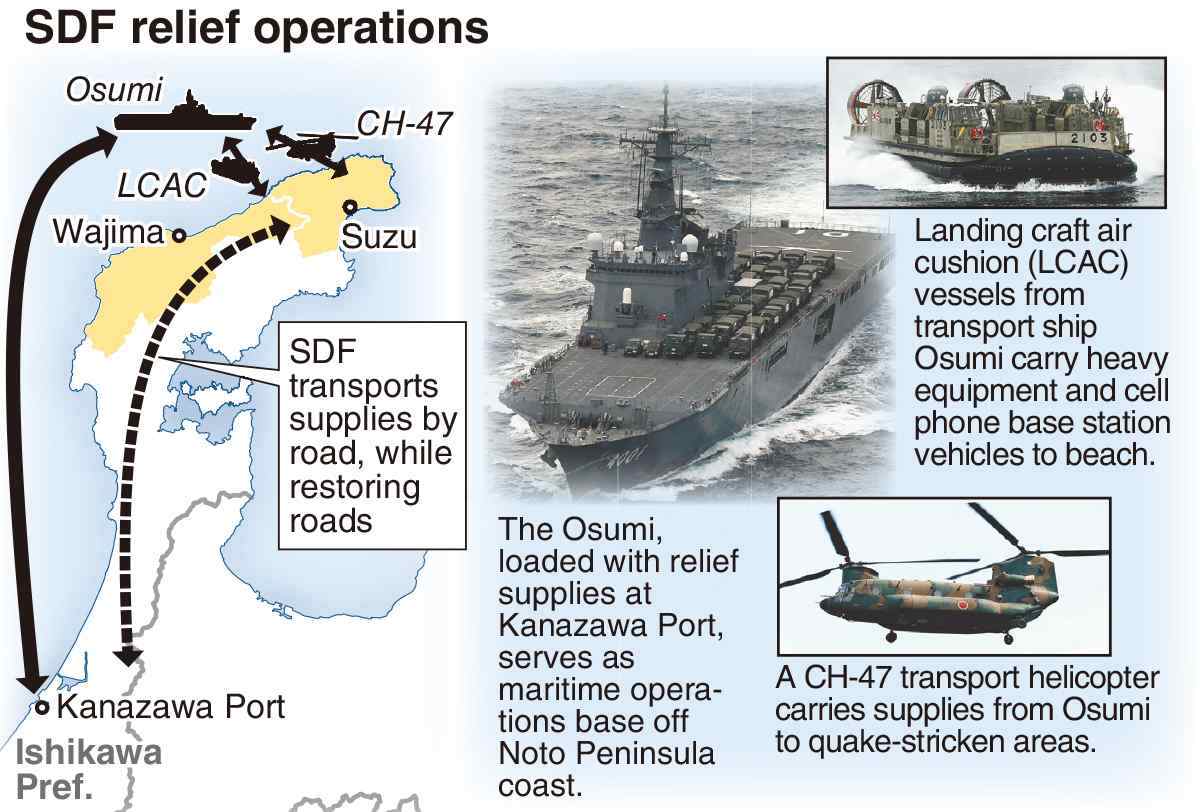
Special team to listen to needs
Supplies carried by the CH-47 to the park are brought to the neighboring Suzu municipal Kenmin Taiikukan gymnasium. They are managed together with other supplies that arrived by road, and are delivered to evacuation centers in various areas.
On Wednesday morning, three SDF personnel wearing epaulets identifying them as part of the “listen to your needs” team were talking to evacuees at municipal Iida Elementary School — about 1 kilometer away from the gymnasium — where about 270 people were taking refuge.
The SDF had formed a 400-member team to listen to the needs of the evacuees in detail.
The SDF team members wrote down the evacuees’ needs and requests in notebooks. One person said there was no alcohol disinfectant, and another said, although they had retort-pouch rice, they had no equipment to heat it.
The government has been providing “push-type assistance,” in which it begins delivering food, blankets and other relief items without waiting for relief applications from local bodies, since the occurrence of the earthquake.
While highly effective in saving lives, this type of aid may not exactly match the specific needs of each affected area or evacuation center. Thus the SDF for the first time introduced a system to centralize requests and manage the needs of those affected by the quake.
Time still needed
Toilet cleaning supplies delivered to the elementary school few days ago were something requested by a 46-year-old woman the day before. Evacuees at the school were troubled by dirty toilets and a deteriorating sanitary environment.
“A girl even got scared and cried since they were so dirty. We are grateful for the supplies,” the woman said.
Meanwhile, a 69-year-old member of a nonprofit organization, who also was staying at the school, said, “Many elderly people say that their backs hurt when they sleep on a futon. There are not enough [cardboard] beds.”
“As time goes by, the range of the support has expanded and the needs of the affected people have become more diverse. It will take much time to listen to the voices of many quake victims, including those in isolated areas,” a senior official of the Defense Ministry said.
"Society" POPULAR ARTICLE
-

M4.9 Earthquake Hits Tokyo, Neighboring Prefectures
-

Israeli Tourists Refused Accommodation at Hotel in Japan’s Nagano Pref., Prompting Protest by Israeli Embassy and Probe by Prefecture
-

M7.5 Earthquake Hits Northern Japan; Tsunami Waves Observed in Hokkaido, Aomori and Iwate Prefectures
-

Tsukiji Market Urges Tourists to Avoid Visiting in Year-End
-

M5.7 Earthquake Hits Japan’s Kumamoto Pref., Measuring Upper 5 Intensity, No Tsunami Expected
JN ACCESS RANKING
-

Keidanren Chairman Yoshinobu Tsutsui Visits Kashiwazaki-Kariwa Nuclear Power Plant; Inspects New Emergency Safety System
-

Imports of Rare Earths from China Facing Delays, May Be Caused by Deterioration of Japan-China Relations
-

Tokyo Economic Security Forum to Hold Inaugural Meeting Amid Tense Global Environment
-

University of Tokyo Professor Discusses Japanese Economic Security in Interview Ahead of Forum
-

Japan Pulls out of Vietnam Nuclear Project, Complicating Hanoi’s Power Plans
